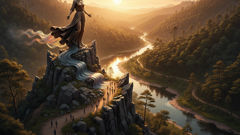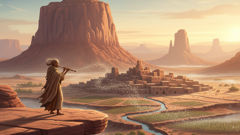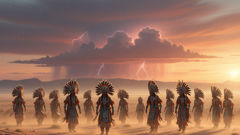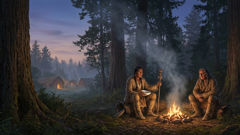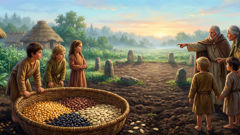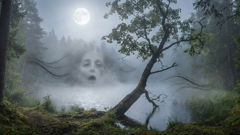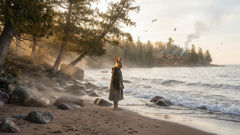Introduction
Long before towns traced straight lines and before iron bridged rivers, the land that would become the Iroquois homeland was an older kind of map—folded ridges, rain-dark soils, and rivers that cut the world into corridors of deep green. The Stonecoats walked those corridors like living geology, moving with a patience more like erosion than breath. In winter they were silhouettes against the pale sky, their shoulders the slope of small hills; in spring, when thaw opened the bones of the earth, they left behind hollows and strange stone heaps that the people pointed to and called the work of giants. The Stonecoats were not merely tall. Their skin had the density of riverstone and the lichen-grown texture of cliff faces; the stories say you could strike them and hear the dull clamp of rock answering rock. They ate like storms—taking livestock, uprooting planted corn, and in the darker, older tales, turning on the unwary human who strayed too deep into their territory. But the myth of the Stonecoats is not only terror; it is the way the Iroquois spoke about boundaries—between humans and wild things, between respect and hubris, between the need to survive and the greed that devours. Across generations, elders described them to children as warnings braided into awe: respect the river’s edge, leave offerings at travel camps when the moon is low, and remember that what looks like a hill may be a sleeping back waiting to awaken. Those generational teachings are the heart of this retelling: a layered, sensory travel through landscape and memory, through the encounters that stitched the Stonecoats into ritual and song, and into the modern echoes that still tint the land with shadow and story.
Origins and the Shape of Stone
To speak of the Stonecoats is to speak of how people read landscape. For the Iroquois, as for many Indigenous nations, the world was a library of stories, each ridge and pool a paragraph in a long, spoken chronicle. The Stonecoats were explained in those paragraphs as figures birthed at the edges of calamity: the ancient cold, the great floods that reshaped valleys, the quarrels among sky-spirits who turned part of themselves into stone to mark territory and forgetfulness. In some tellings, the Stonecoats were the children of a tempest and a cliff, a nocturnal union that left them slow and enduring. In others, they were remnants of a forgotten people, their bodies turned to rock by a long curse that preserved their hunger but took their warmth. These competing beginnings did not contradict each other so much as allow different parts of landscape and human experience to be explained. A boulder on a riverbank, a circle of unnaturally smooth stones, a series of human bones found beneath a granite overhang—each could be linked to a version of the Stonecoats’ past.

The first paragraph of this retelling pauses against the concrete: imagine a Stonecoat’s first breath. It is the sound of pebbles settling after frost. The skin takes shape like shale, plate upon plate, flaking where a tendon moves. Eyes, where they appear in the oldest songs, are the dark of river pools—deep, patient, reflecting stars with an indifference that frightens hunters and comforts the land. The giants’ anatomy, in the imaginations that passed these stories down, mirrors the geological processes that commanded survival. They are slow, but their slowness is genocidal in its own way: a stalk of corn can be unrooted cleanly by a single, sure hand. A boat waiting at the bend can be upended by a single knee. Cannibalism appears in the tales not as gratuitous horror but as the most extreme symbol of crossing a boundary—the last ultimate transgression that returns human flesh to the stone, completes the monstrous inversion of human into landscape and back again. That inversion is essential to understanding how the Iroquois used the Stonecoats as moral instruments. They make literal the idea that when people behave as if they own the land, the land can own them back.
There are specific places on the map where the Stonecoats are spoken of with a particular hush. Along the north arm of a braided river—streams that change course with every great thaw—the ground bears outcroppings carved into chairlike depressions. Elders would tell of a giant who sat through an entire winter, arms folded, and when the thaw came the seat remained. Another place is a broken ridge that looks like a fallen shoulder; children are warned not to climb it because that shoulder might shudder and send loose stones tumbling like teeth. These topographical features became mnemonic devices: physical markers that anchored memory. When a child learned the name of the place, the name also taught how to behave, where to walk and where to whisper. Even beyond their physical presence, Stonecoats function as a cognitive map—a way to mark danger without forbidding curiosity entirely.
Yet their stone hides made them more than topography; the giants aged like mountains. The surface of their bodies bore scars of glacial scrape and river polish, their knuckles sometimes thick with embedded quartz that shimmered when they moved. Hunters and gatherers described finding teeth made of flint, and pottery shards jammed into crevices where flint had served as a talisman. The giants’ connection to stone made human attempts to fight them seem both ridiculous and perilous. Weapons that sank into flesh would clang against rock, leaving blades dulled, arrows snapped, and a smattering of fatal stones where a warrior had fallen. Around these tales coalesced rituals: never go unarmed into certain valleys, always leave a portion of your kill at a travel shrine, and never speak a Stonecoat’s name aloud on nights thick with fog. The rituals were not simply superstition; they were survival tactics encoded as story, teaching groups how to travel together, share resources, and respect hidden thresholds.
Language plays a role in the myth’s durability. The Iroquois tongue carries nuances about rock and flesh that English cannot hold neatly; words for different kinds of stone, for the way water wounds a ledge, and for the sound of loose gravel underfoot are all part of the same semantic family. This linguistic web lets the myth bind to daily life: calling a place a Stonecoat-place was as much about the carefulness one must bring there as it was about the possibility of encountering a giant. When Europeans later transcribed these tales, much of the etymology and intention was lost, but the persistence of place names and the stubbornness of the landscape itself ensured that the Stonecoat stories remained. Geologists came and named the processes—glacial scouring, frost wedging, fluvial abrasion—but the elders’ stories had already translated those terms into moral prescriptions. To speak of a Stonecoat is to teach how to read a shoreline, how to know when the ice is thin, and how to understand that the earth’s features can be as watchful as any animal.
There is also the matter of hunger. Many speeches about Stonecoats emphasize appetite as a force: the giants hungered like winter hungers, inexorable, reshaping small communities by taking what they needed. In certain versions, cannibalism appears as a sign of desperation, a reminder that in a world of scarce calories, boundaries can crumble. In others, it is a symptom of moral rot, the final proof that someone or something has crossed the sacred line separating human society from the unbound law of appetite. The stories differ, but the lesson holds steady: when community bonds fray, when traditions of giving and restraint are abandoned, the world replies in kind. The Stonecoats—part geology, part moral mirror—embody what happens when hunger becomes the measure of everything.
Studying the Stonecoats also requires listening to songs. Elders would perform slow chants that mimic the rhythm of rockslides or the drip of spring thaw. Children learned these songs as lullabies and warnings. The music frames the giants not only as monsters to fear but also as members of the world with whom one might negotiate. Gifts were left at wayside shrines—maize wrapped in bark, a carved stone, a small bell whose sound could be heard across a stream. These offerings are recorded in many versions of the tale: treat the earth with humility, and the Stonecoats will pass you by. Fail to understand the language of reciprocity, and you may find bone beneath boulder and claw-marked bark where a friend once stood. Through ritual and story, the Stonecoats teach the ancient lessons of stewardship and the consequences of disrupting the connective tissue between people and place.
Encounters, Lessons, and the Modern Echo
Stories of clear encounters with Stonecoats cluster into certain motifs: a traveler ignores a warning sign, a child wanders off in fog, a party of hunters camps without leaving offerings, and the land answers with a presence that is both patient and enormous. One such tale tells of a young man named Ahsen, who set out at dusk to prove his bravery before a coming winter. He slipped from the company of his aunt and walked along a riverrun that would later be known as a Stonecoat-place. The story lingers on the small details—how the mud cooled underfoot, how a heron lifted into the last light, how Ahsen paused to line a flint arrow in silence—because the smallest things underscore the fragility of human habit against the slow intelligence of stone. Ahsen stumbled upon a mound that looked like a sleeping shoulder. He slashed at the moss with his knife to pry at a strange white growth, and the skin split like old varnish to reveal hair threaded through rock. Horrified, he tried to run, but the giant woke as slowly as winter breaking; the land rearranged itself in monstrous increments, and by the time the story finishes, Ahsen is either swallowed, turned to a stone effigy, or saved by a sister who leaves an offering and sings the right song. The variations of the ending correspond to values the teller wishes to emphasize—either the inevitability of consequence or the redemptive power of ritual and community.

A second motif centers on the idea of negotiation. The Stonecoats are not uniformly malevolent in every telling; some versions make them guardians of certain groves, their hunger tempered by a reciprocal exchange. In those narratives, a family loses corn to the giants but is spared when they respond with a small offering and a promise to check traps frequently, to share catches during lean years, and to respect old travel routes. There is wisdom embedded here: the Stonecoats serve as a metaphor for ecological balance. When humans take more than they give, the land tightens around them. When humans adapt and remember reciprocity, the giants’ relationship with people becomes tolerable, even protective. That tension—between fear and negotiation—reflects the lived reality of hunting societies who both relied on and feared the forces that provided food. The giants were a narrative device to help calibrate restraint.
As Europeans arrived and the pressures of new economies and new diseases reshaped life, Stonecoat stories evolved again. Missionaries and traders recorded versions of the tales that emphasize monstrous horror to fit colonial expectations of savage otherness, while many Indigenous retellings clung to the subtler lessons about stewardship. The Stonecoats became a point of cultural friction: settlers who read the land only as extractable resource clashed with people who maintained ritual obligations and territorial knowledge. The giants, in some stories, reacted to the new, everyday violence by becoming more assertive—toppling mills, unseating bridges, gnawing at the foundations of cabins that sat where a giant once walked. These accounts may sound like allegory, but they also reflect real ecological consequences: deforestation altered heating and wind patterns, dams changed currents, and the land responded in ways that communities needed to interpret. The Stonecoat myth provided a moral vocabulary to discuss those changes: when you take from a system without returning, the system alters in ways that can swallow livelihoods.
In the modern era, the Stonecoat figures have migrated into different media: museum exhibits, historical novels, horror stories, and even conservation campaigns that use the giants as a symbol of landscape memory. There is a risk of romanticization or distortion—of turning a solemn, instructive myth into mere spectacle. But there is also opportunity. Conservationists have used Stonecoat stories as a cultural hook to engage communities in preserving river corridors and old growth patches. When people are invited to learn the old songs and the place names, when they are shown the way certain stone formations mark ancient pathways, stewardship becomes less abstract. The giants thus find new life as teaching tools for ecological responsibility, bridging an ancestral ethic to contemporary environmental science. In some towns, guided walks revisit places called Stonecoat-mounds. Elders tell stories under the same sky, and schoolchildren learn the old rituals alongside maps that show floodplains and sediment deposits. The myth becomes a pedagogical instrument, bringing together oral tradition and modern ecology to foster a culture of careful living.
The Stonecoats also speak to personal, psychological terrain. Where the landscape offers a stern teacher, the Stonecoats can stand in for grief or trauma—forces that harden people from the inside out. In certain contemporary retellings, a person hardened by loss is described in Stonecoat terms: skin like river rock, steps slow and certain, appetite not for food but for the patterns that provide illusionary relief. These psychological readings risk reducing myth to metaphor, but they do capture something true: myths are tools for making sense of interior weather. They give vocabulary to experience, whether it is the chill of a town where mills closed, the slow corrosion of social ties, or the numb defense that allows one to survive trauma but also to become impermeable to joy. The Stonecoats remind us the land and the self can both calcify, and that thaw—when it comes—must be careful, not catastrophic.
Archeological notes complicate pure legend. Scholars find boulders in arrangements that human hands likely moved and human remains in sites near rock shelters. Radiocarbon dates place some activities thousands of years in the past. While no scientist has ever verified a literal species of stone-skinned giants, the material culture—ceramics, carved stone adzes, traces of hearths—correlate with the places the stories name. The myth sits atop a scaffold of real human activity, and that connection lends it a weight beyond the purely fantastical. The power of the Stonecoat story is its capacity to encode land-use practices, to mark dangerous places, to create a ritualized economy of exchange, and to teach children by imagination rather than purely by admonition.
To retell these encounters responsibly is to honor those multiple registers. It requires acknowledging the myth’s moral core—reciprocity with the earth—while also situating the tales within colonial histories that attempted to flatten and misinterpret Indigenous knowledge. It means listening to elders, not just archives; following place names on maps that colonial surveyors frequently erased; and treating the Stonecoats not as monsters to be hunted for entertainment but as lessons embedded in a living cultural ecology. Where the giants once enforced boundaries by appetite, modern storytellers can use their myth to enforce boundaries of respect: between curiosity and appropriation, between scholarship and consent, between the storyteller and the stories’ original keepers.
The final theme to emerge from repeated encounters is humility. The Stonecoats, massive and indifferent, remind humans of scale. They are a practical admonition against hubris. In a world that prizes the ability to reshape and dominate, the myth insists on another value—stewardship. If one listens, these legends contain practical wisdom about reading weathered stone and shifting rivers, about the importance of leaving offerings, and about how societies survive by honouring limits. In that way, the Stonecoats continue to teach, their stone backs slowly eroding under wind and time, their stories shaping how people still move through the world.
Conclusion
The Stonecoats endure because they answer a layered human need: to explain strange formations in the land, to encode survival strategies into story, and to bind a community with rituals of respect and reciprocity. They are not only terrifying; they are teachers of scale and caution, mediators between human appetite and the patient metabolism of earth. When elders warn a child not to climb a certain shoulder of stone, they transmit an entire philosophy of living softly on a place. When a conservation program evokes the giants to remind people of floodplains and root systems, it revives a pragmatic ethic clothed in myth. In a time when landscapes are changing faster than memory, the cautionary tales of stone-skinned giants offer a vocabulary to understand those changes and to act with more care. The stories press a single insistence into the mind: respect the thresholds, honor the offerings, and listen to the land’s subtle language. If a community forgets those rules, the legend sternly suggests, the world will not forget them. The Stonecoats will remain—patient, indifferent, and immovable—proof that the earth remembers what people do and that myth is sometimes the hand a culture uses to steady itself against forgetting.


